Starbucks Business Report
VerifiedAdded on 2023/01/18
|17
|5239
|61
AI Summary
This business report provides a detailed analysis of Starbucks, including its competitive position, external and internal environment, and recommendations for improvement. It explores the challenges and opportunities in the coffee industry and offers insights into Starbucks' strategies for the next 3 years.
Contribute Materials
Your contribution can guide someone’s learning journey. Share your
documents today.
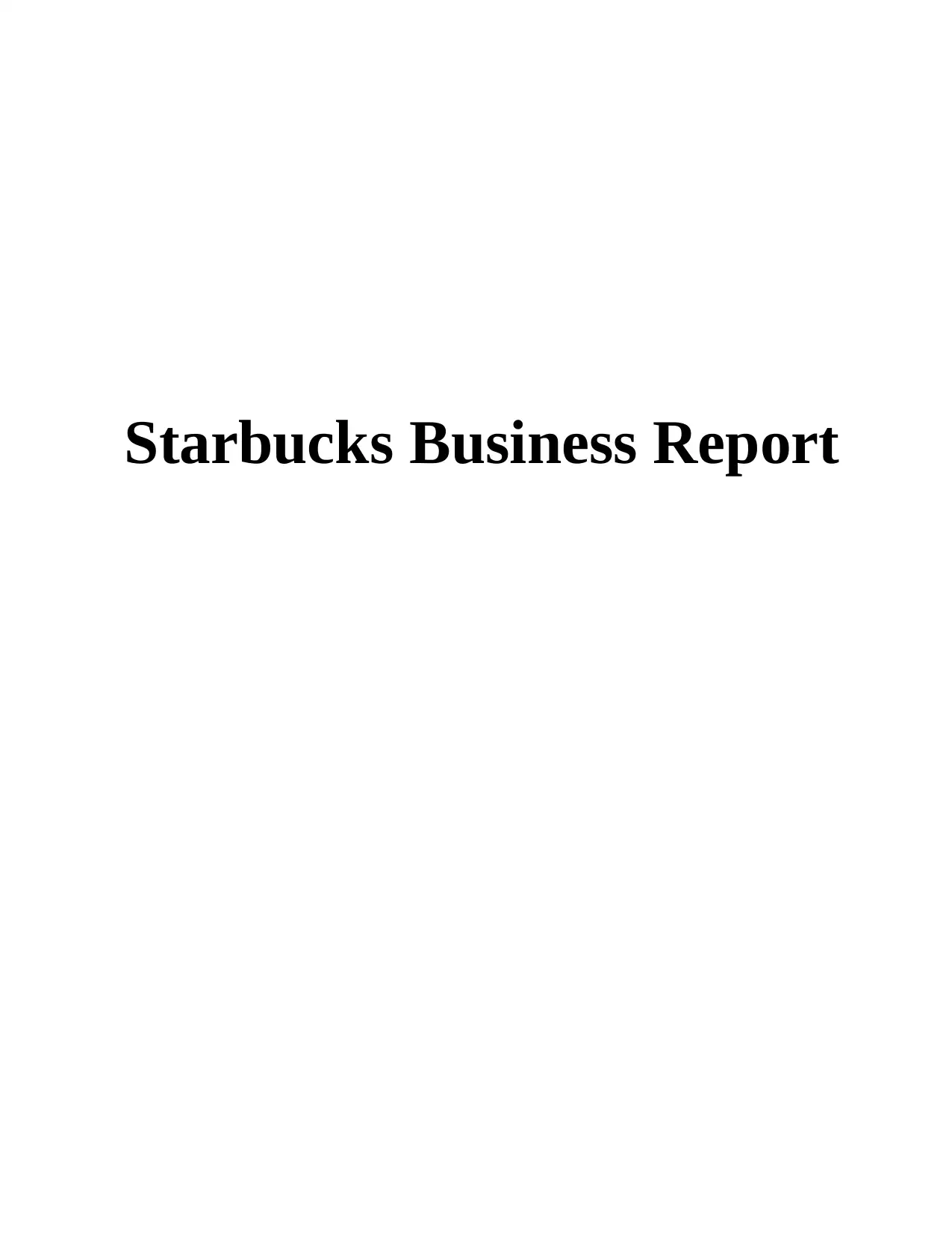
Starbucks Business Report
Secure Best Marks with AI Grader
Need help grading? Try our AI Grader for instant feedback on your assignments.
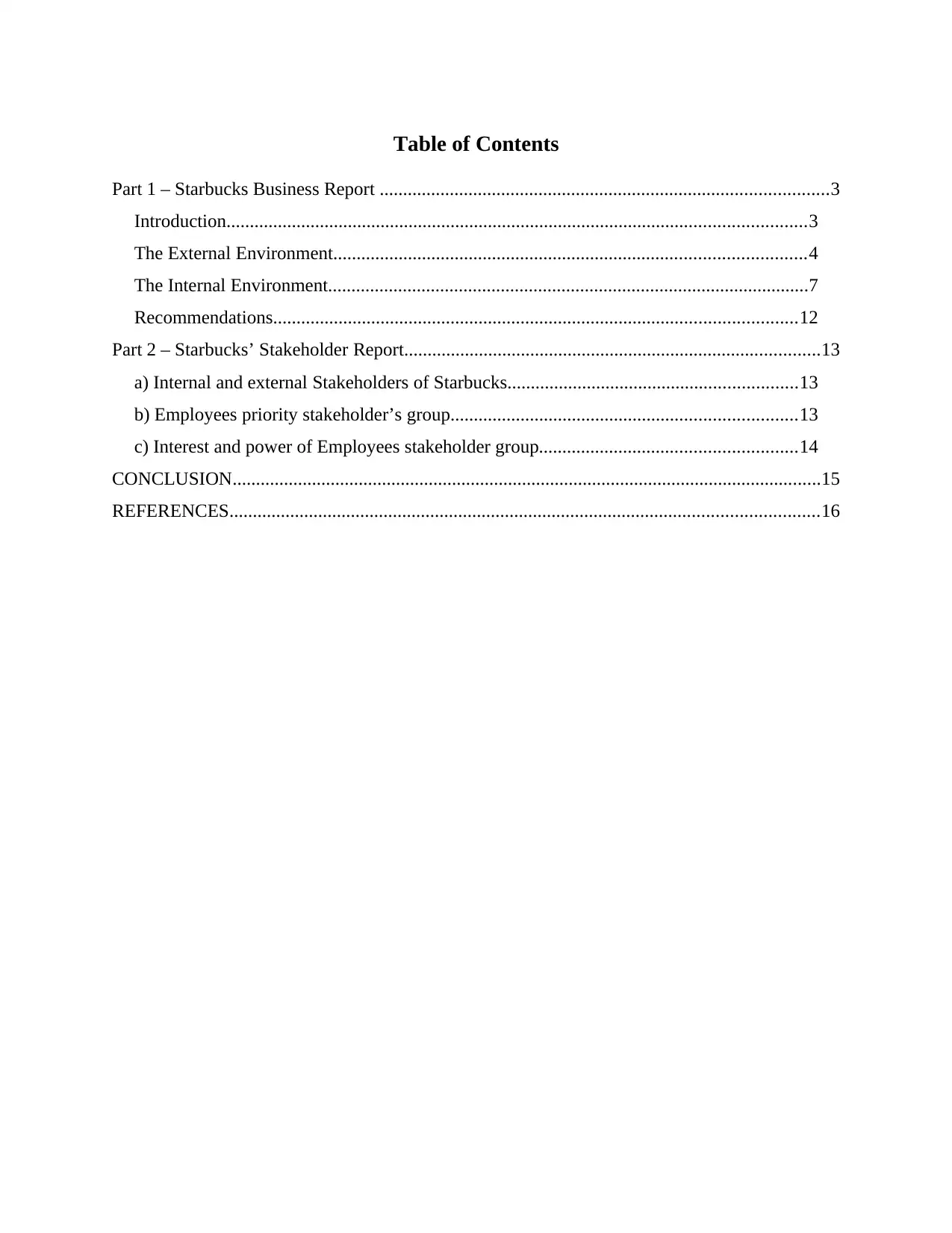
Table of Contents
Part 1 – Starbucks Business Report ................................................................................................3
Introduction............................................................................................................................3
The External Environment.....................................................................................................4
The Internal Environment.......................................................................................................7
Recommendations................................................................................................................12
Part 2 – Starbucks’ Stakeholder Report.........................................................................................13
a) Internal and external Stakeholders of Starbucks..............................................................13
b) Employees priority stakeholder’s group..........................................................................13
c) Interest and power of Employees stakeholder group.......................................................14
CONCLUSION..............................................................................................................................15
REFERENCES..............................................................................................................................16
Part 1 – Starbucks Business Report ................................................................................................3
Introduction............................................................................................................................3
The External Environment.....................................................................................................4
The Internal Environment.......................................................................................................7
Recommendations................................................................................................................12
Part 2 – Starbucks’ Stakeholder Report.........................................................................................13
a) Internal and external Stakeholders of Starbucks..............................................................13
b) Employees priority stakeholder’s group..........................................................................13
c) Interest and power of Employees stakeholder group.......................................................14
CONCLUSION..............................................................................................................................15
REFERENCES..............................................................................................................................16
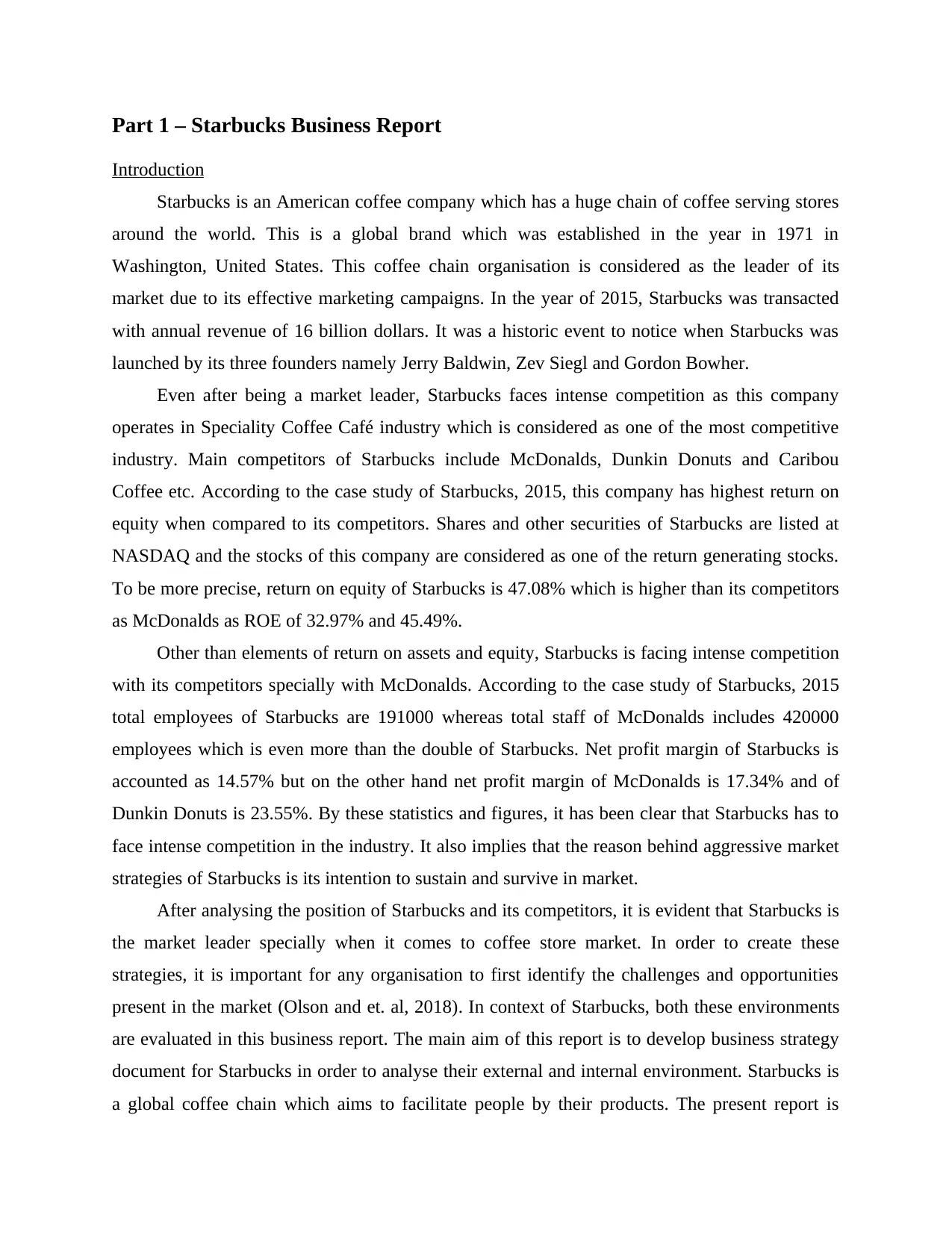
Part 1 – Starbucks Business Report
Introduction
Starbucks is an American coffee company which has a huge chain of coffee serving stores
around the world. This is a global brand which was established in the year in 1971 in
Washington, United States. This coffee chain organisation is considered as the leader of its
market due to its effective marketing campaigns. In the year of 2015, Starbucks was transacted
with annual revenue of 16 billion dollars. It was a historic event to notice when Starbucks was
launched by its three founders namely Jerry Baldwin, Zev Siegl and Gordon Bowher.
Even after being a market leader, Starbucks faces intense competition as this company
operates in Speciality Coffee Café industry which is considered as one of the most competitive
industry. Main competitors of Starbucks include McDonalds, Dunkin Donuts and Caribou
Coffee etc. According to the case study of Starbucks, 2015, this company has highest return on
equity when compared to its competitors. Shares and other securities of Starbucks are listed at
NASDAQ and the stocks of this company are considered as one of the return generating stocks.
To be more precise, return on equity of Starbucks is 47.08% which is higher than its competitors
as McDonalds as ROE of 32.97% and 45.49%.
Other than elements of return on assets and equity, Starbucks is facing intense competition
with its competitors specially with McDonalds. According to the case study of Starbucks, 2015
total employees of Starbucks are 191000 whereas total staff of McDonalds includes 420000
employees which is even more than the double of Starbucks. Net profit margin of Starbucks is
accounted as 14.57% but on the other hand net profit margin of McDonalds is 17.34% and of
Dunkin Donuts is 23.55%. By these statistics and figures, it has been clear that Starbucks has to
face intense competition in the industry. It also implies that the reason behind aggressive market
strategies of Starbucks is its intention to sustain and survive in market.
After analysing the position of Starbucks and its competitors, it is evident that Starbucks is
the market leader specially when it comes to coffee store market. In order to create these
strategies, it is important for any organisation to first identify the challenges and opportunities
present in the market (Olson and et. al, 2018). In context of Starbucks, both these environments
are evaluated in this business report. The main aim of this report is to develop business strategy
document for Starbucks in order to analyse their external and internal environment. Starbucks is
a global coffee chain which aims to facilitate people by their products. The present report is
Introduction
Starbucks is an American coffee company which has a huge chain of coffee serving stores
around the world. This is a global brand which was established in the year in 1971 in
Washington, United States. This coffee chain organisation is considered as the leader of its
market due to its effective marketing campaigns. In the year of 2015, Starbucks was transacted
with annual revenue of 16 billion dollars. It was a historic event to notice when Starbucks was
launched by its three founders namely Jerry Baldwin, Zev Siegl and Gordon Bowher.
Even after being a market leader, Starbucks faces intense competition as this company
operates in Speciality Coffee Café industry which is considered as one of the most competitive
industry. Main competitors of Starbucks include McDonalds, Dunkin Donuts and Caribou
Coffee etc. According to the case study of Starbucks, 2015, this company has highest return on
equity when compared to its competitors. Shares and other securities of Starbucks are listed at
NASDAQ and the stocks of this company are considered as one of the return generating stocks.
To be more precise, return on equity of Starbucks is 47.08% which is higher than its competitors
as McDonalds as ROE of 32.97% and 45.49%.
Other than elements of return on assets and equity, Starbucks is facing intense competition
with its competitors specially with McDonalds. According to the case study of Starbucks, 2015
total employees of Starbucks are 191000 whereas total staff of McDonalds includes 420000
employees which is even more than the double of Starbucks. Net profit margin of Starbucks is
accounted as 14.57% but on the other hand net profit margin of McDonalds is 17.34% and of
Dunkin Donuts is 23.55%. By these statistics and figures, it has been clear that Starbucks has to
face intense competition in the industry. It also implies that the reason behind aggressive market
strategies of Starbucks is its intention to sustain and survive in market.
After analysing the position of Starbucks and its competitors, it is evident that Starbucks is
the market leader specially when it comes to coffee store market. In order to create these
strategies, it is important for any organisation to first identify the challenges and opportunities
present in the market (Olson and et. al, 2018). In context of Starbucks, both these environments
are evaluated in this business report. The main aim of this report is to develop business strategy
document for Starbucks in order to analyse their external and internal environment. Starbucks is
a global coffee chain which aims to facilitate people by their products. The present report is
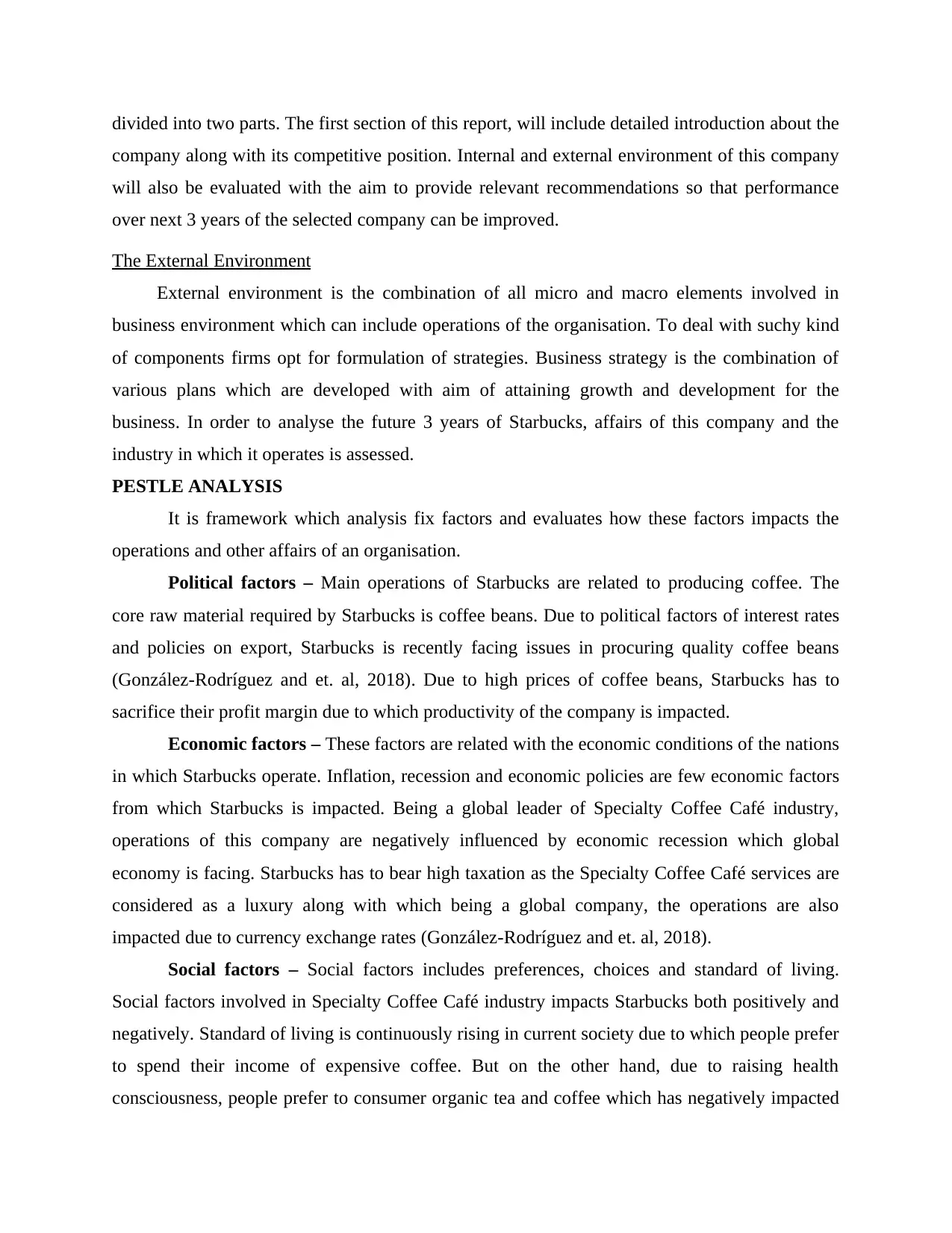
divided into two parts. The first section of this report, will include detailed introduction about the
company along with its competitive position. Internal and external environment of this company
will also be evaluated with the aim to provide relevant recommendations so that performance
over next 3 years of the selected company can be improved.
The External Environment
External environment is the combination of all micro and macro elements involved in
business environment which can include operations of the organisation. To deal with suchy kind
of components firms opt for formulation of strategies. Business strategy is the combination of
various plans which are developed with aim of attaining growth and development for the
business. In order to analyse the future 3 years of Starbucks, affairs of this company and the
industry in which it operates is assessed.
PESTLE ANALYSIS
It is framework which analysis fix factors and evaluates how these factors impacts the
operations and other affairs of an organisation.
Political factors – Main operations of Starbucks are related to producing coffee. The
core raw material required by Starbucks is coffee beans. Due to political factors of interest rates
and policies on export, Starbucks is recently facing issues in procuring quality coffee beans
(González-Rodríguez and et. al, 2018). Due to high prices of coffee beans, Starbucks has to
sacrifice their profit margin due to which productivity of the company is impacted.
Economic factors – These factors are related with the economic conditions of the nations
in which Starbucks operate. Inflation, recession and economic policies are few economic factors
from which Starbucks is impacted. Being a global leader of Specialty Coffee Café industry,
operations of this company are negatively influenced by economic recession which global
economy is facing. Starbucks has to bear high taxation as the Specialty Coffee Café services are
considered as a luxury along with which being a global company, the operations are also
impacted due to currency exchange rates (González-Rodríguez and et. al, 2018).
Social factors – Social factors includes preferences, choices and standard of living.
Social factors involved in Specialty Coffee Café industry impacts Starbucks both positively and
negatively. Standard of living is continuously rising in current society due to which people prefer
to spend their income of expensive coffee. But on the other hand, due to raising health
consciousness, people prefer to consumer organic tea and coffee which has negatively impacted
company along with its competitive position. Internal and external environment of this company
will also be evaluated with the aim to provide relevant recommendations so that performance
over next 3 years of the selected company can be improved.
The External Environment
External environment is the combination of all micro and macro elements involved in
business environment which can include operations of the organisation. To deal with suchy kind
of components firms opt for formulation of strategies. Business strategy is the combination of
various plans which are developed with aim of attaining growth and development for the
business. In order to analyse the future 3 years of Starbucks, affairs of this company and the
industry in which it operates is assessed.
PESTLE ANALYSIS
It is framework which analysis fix factors and evaluates how these factors impacts the
operations and other affairs of an organisation.
Political factors – Main operations of Starbucks are related to producing coffee. The
core raw material required by Starbucks is coffee beans. Due to political factors of interest rates
and policies on export, Starbucks is recently facing issues in procuring quality coffee beans
(González-Rodríguez and et. al, 2018). Due to high prices of coffee beans, Starbucks has to
sacrifice their profit margin due to which productivity of the company is impacted.
Economic factors – These factors are related with the economic conditions of the nations
in which Starbucks operate. Inflation, recession and economic policies are few economic factors
from which Starbucks is impacted. Being a global leader of Specialty Coffee Café industry,
operations of this company are negatively influenced by economic recession which global
economy is facing. Starbucks has to bear high taxation as the Specialty Coffee Café services are
considered as a luxury along with which being a global company, the operations are also
impacted due to currency exchange rates (González-Rodríguez and et. al, 2018).
Social factors – Social factors includes preferences, choices and standard of living.
Social factors involved in Specialty Coffee Café industry impacts Starbucks both positively and
negatively. Standard of living is continuously rising in current society due to which people prefer
to spend their income of expensive coffee. But on the other hand, due to raising health
consciousness, people prefer to consumer organic tea and coffee which has negatively impacted
Secure Best Marks with AI Grader
Need help grading? Try our AI Grader for instant feedback on your assignments.
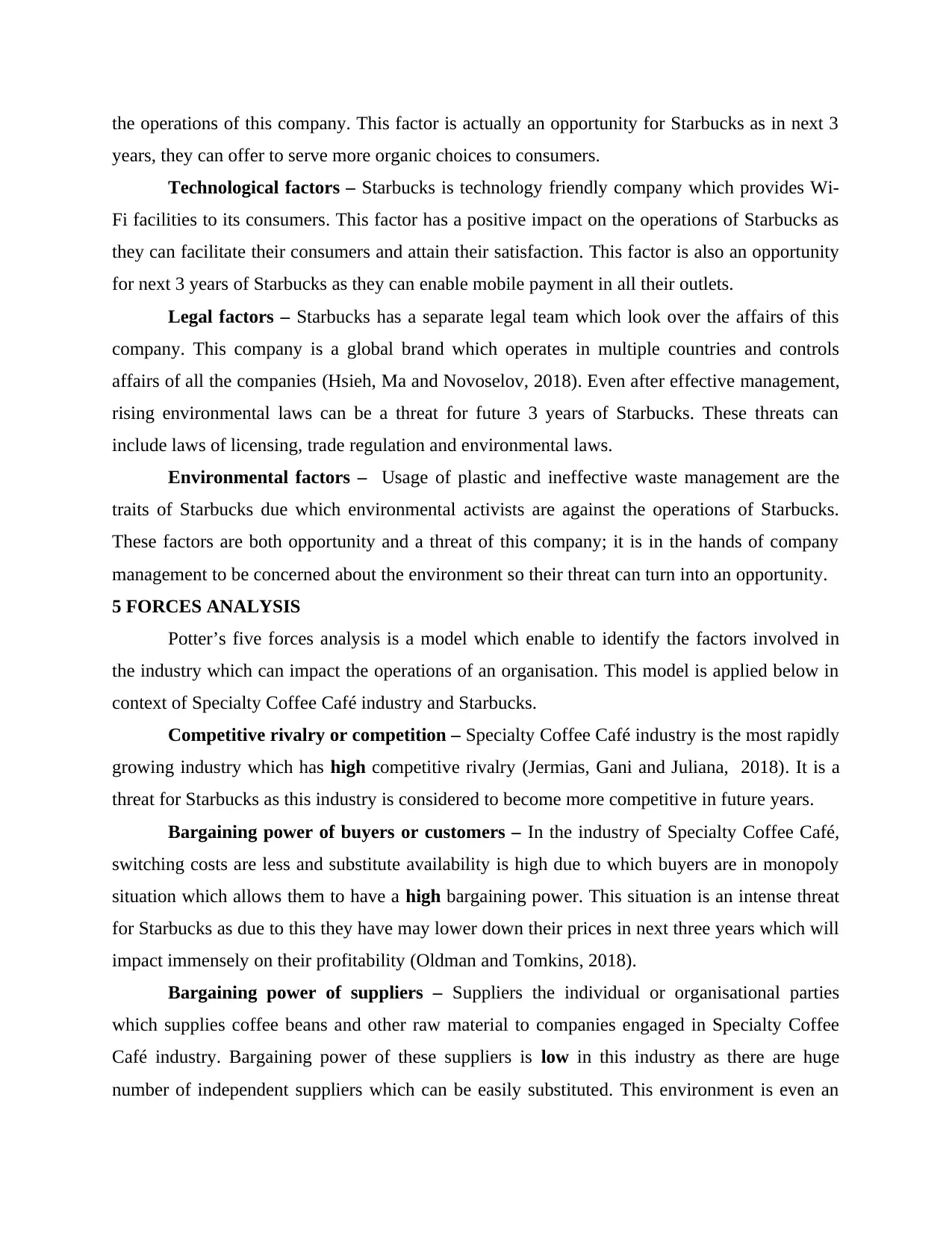
the operations of this company. This factor is actually an opportunity for Starbucks as in next 3
years, they can offer to serve more organic choices to consumers.
Technological factors – Starbucks is technology friendly company which provides Wi-
Fi facilities to its consumers. This factor has a positive impact on the operations of Starbucks as
they can facilitate their consumers and attain their satisfaction. This factor is also an opportunity
for next 3 years of Starbucks as they can enable mobile payment in all their outlets.
Legal factors – Starbucks has a separate legal team which look over the affairs of this
company. This company is a global brand which operates in multiple countries and controls
affairs of all the companies (Hsieh, Ma and Novoselov, 2018). Even after effective management,
rising environmental laws can be a threat for future 3 years of Starbucks. These threats can
include laws of licensing, trade regulation and environmental laws.
Environmental factors – Usage of plastic and ineffective waste management are the
traits of Starbucks due which environmental activists are against the operations of Starbucks.
These factors are both opportunity and a threat of this company; it is in the hands of company
management to be concerned about the environment so their threat can turn into an opportunity.
5 FORCES ANALYSIS
Potter’s five forces analysis is a model which enable to identify the factors involved in
the industry which can impact the operations of an organisation. This model is applied below in
context of Specialty Coffee Café industry and Starbucks.
Competitive rivalry or competition – Specialty Coffee Café industry is the most rapidly
growing industry which has high competitive rivalry (Jermias, Gani and Juliana, 2018). It is a
threat for Starbucks as this industry is considered to become more competitive in future years.
Bargaining power of buyers or customers – In the industry of Specialty Coffee Café,
switching costs are less and substitute availability is high due to which buyers are in monopoly
situation which allows them to have a high bargaining power. This situation is an intense threat
for Starbucks as due to this they have may lower down their prices in next three years which will
impact immensely on their profitability (Oldman and Tomkins, 2018).
Bargaining power of suppliers – Suppliers the individual or organisational parties
which supplies coffee beans and other raw material to companies engaged in Specialty Coffee
Café industry. Bargaining power of these suppliers is low in this industry as there are huge
number of independent suppliers which can be easily substituted. This environment is even an
years, they can offer to serve more organic choices to consumers.
Technological factors – Starbucks is technology friendly company which provides Wi-
Fi facilities to its consumers. This factor has a positive impact on the operations of Starbucks as
they can facilitate their consumers and attain their satisfaction. This factor is also an opportunity
for next 3 years of Starbucks as they can enable mobile payment in all their outlets.
Legal factors – Starbucks has a separate legal team which look over the affairs of this
company. This company is a global brand which operates in multiple countries and controls
affairs of all the companies (Hsieh, Ma and Novoselov, 2018). Even after effective management,
rising environmental laws can be a threat for future 3 years of Starbucks. These threats can
include laws of licensing, trade regulation and environmental laws.
Environmental factors – Usage of plastic and ineffective waste management are the
traits of Starbucks due which environmental activists are against the operations of Starbucks.
These factors are both opportunity and a threat of this company; it is in the hands of company
management to be concerned about the environment so their threat can turn into an opportunity.
5 FORCES ANALYSIS
Potter’s five forces analysis is a model which enable to identify the factors involved in
the industry which can impact the operations of an organisation. This model is applied below in
context of Specialty Coffee Café industry and Starbucks.
Competitive rivalry or competition – Specialty Coffee Café industry is the most rapidly
growing industry which has high competitive rivalry (Jermias, Gani and Juliana, 2018). It is a
threat for Starbucks as this industry is considered to become more competitive in future years.
Bargaining power of buyers or customers – In the industry of Specialty Coffee Café,
switching costs are less and substitute availability is high due to which buyers are in monopoly
situation which allows them to have a high bargaining power. This situation is an intense threat
for Starbucks as due to this they have may lower down their prices in next three years which will
impact immensely on their profitability (Oldman and Tomkins, 2018).
Bargaining power of suppliers – Suppliers the individual or organisational parties
which supplies coffee beans and other raw material to companies engaged in Specialty Coffee
Café industry. Bargaining power of these suppliers is low in this industry as there are huge
number of independent suppliers which can be easily substituted. This environment is even an
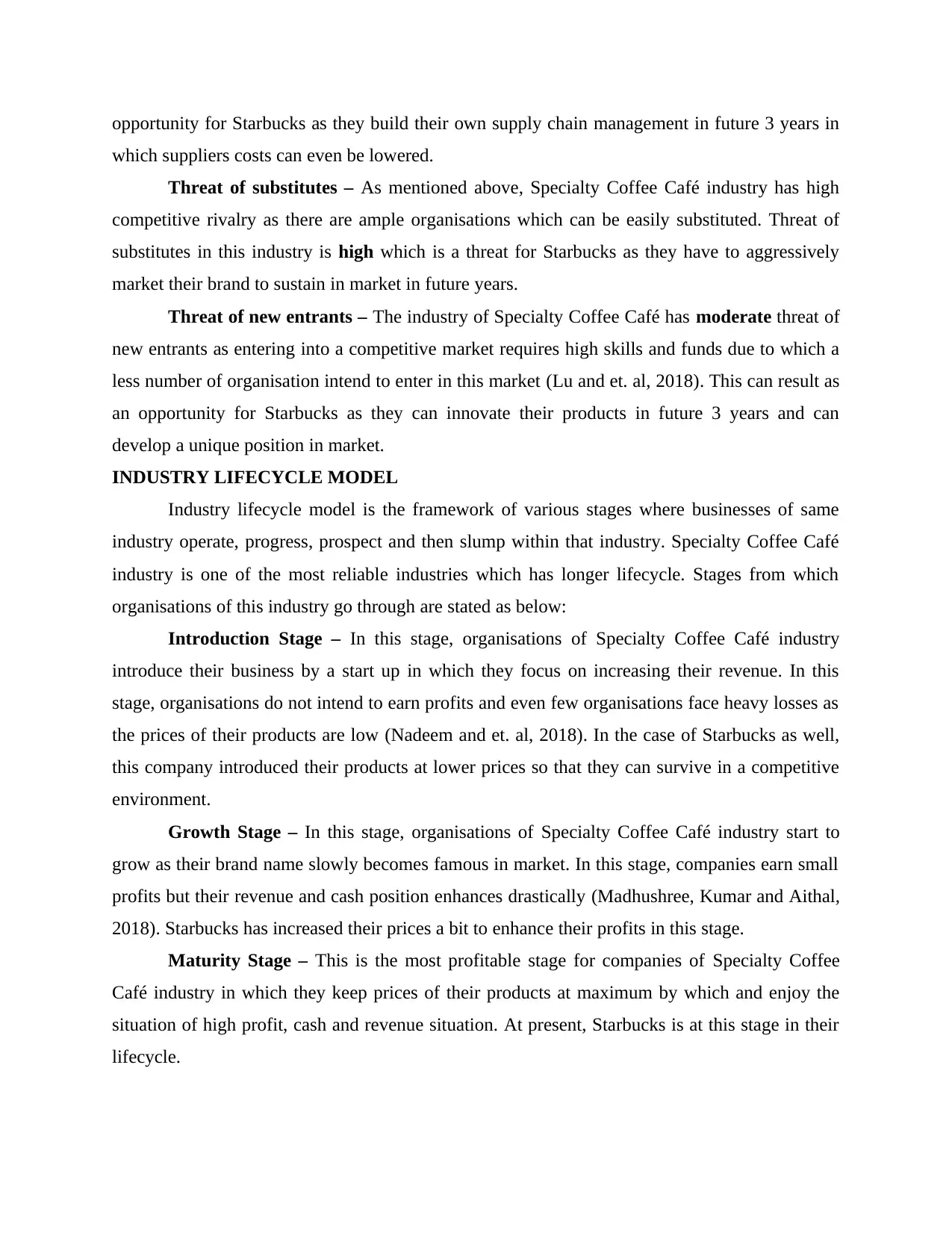
opportunity for Starbucks as they build their own supply chain management in future 3 years in
which suppliers costs can even be lowered.
Threat of substitutes – As mentioned above, Specialty Coffee Café industry has high
competitive rivalry as there are ample organisations which can be easily substituted. Threat of
substitutes in this industry is high which is a threat for Starbucks as they have to aggressively
market their brand to sustain in market in future years.
Threat of new entrants – The industry of Specialty Coffee Café has moderate threat of
new entrants as entering into a competitive market requires high skills and funds due to which a
less number of organisation intend to enter in this market (Lu and et. al, 2018). This can result as
an opportunity for Starbucks as they can innovate their products in future 3 years and can
develop a unique position in market.
INDUSTRY LIFECYCLE MODEL
Industry lifecycle model is the framework of various stages where businesses of same
industry operate, progress, prospect and then slump within that industry. Specialty Coffee Café
industry is one of the most reliable industries which has longer lifecycle. Stages from which
organisations of this industry go through are stated as below:
Introduction Stage – In this stage, organisations of Specialty Coffee Café industry
introduce their business by a start up in which they focus on increasing their revenue. In this
stage, organisations do not intend to earn profits and even few organisations face heavy losses as
the prices of their products are low (Nadeem and et. al, 2018). In the case of Starbucks as well,
this company introduced their products at lower prices so that they can survive in a competitive
environment.
Growth Stage – In this stage, organisations of Specialty Coffee Café industry start to
grow as their brand name slowly becomes famous in market. In this stage, companies earn small
profits but their revenue and cash position enhances drastically (Madhushree, Kumar and Aithal,
2018). Starbucks has increased their prices a bit to enhance their profits in this stage.
Maturity Stage – This is the most profitable stage for companies of Specialty Coffee
Café industry in which they keep prices of their products at maximum by which and enjoy the
situation of high profit, cash and revenue situation. At present, Starbucks is at this stage in their
lifecycle.
which suppliers costs can even be lowered.
Threat of substitutes – As mentioned above, Specialty Coffee Café industry has high
competitive rivalry as there are ample organisations which can be easily substituted. Threat of
substitutes in this industry is high which is a threat for Starbucks as they have to aggressively
market their brand to sustain in market in future years.
Threat of new entrants – The industry of Specialty Coffee Café has moderate threat of
new entrants as entering into a competitive market requires high skills and funds due to which a
less number of organisation intend to enter in this market (Lu and et. al, 2018). This can result as
an opportunity for Starbucks as they can innovate their products in future 3 years and can
develop a unique position in market.
INDUSTRY LIFECYCLE MODEL
Industry lifecycle model is the framework of various stages where businesses of same
industry operate, progress, prospect and then slump within that industry. Specialty Coffee Café
industry is one of the most reliable industries which has longer lifecycle. Stages from which
organisations of this industry go through are stated as below:
Introduction Stage – In this stage, organisations of Specialty Coffee Café industry
introduce their business by a start up in which they focus on increasing their revenue. In this
stage, organisations do not intend to earn profits and even few organisations face heavy losses as
the prices of their products are low (Nadeem and et. al, 2018). In the case of Starbucks as well,
this company introduced their products at lower prices so that they can survive in a competitive
environment.
Growth Stage – In this stage, organisations of Specialty Coffee Café industry start to
grow as their brand name slowly becomes famous in market. In this stage, companies earn small
profits but their revenue and cash position enhances drastically (Madhushree, Kumar and Aithal,
2018). Starbucks has increased their prices a bit to enhance their profits in this stage.
Maturity Stage – This is the most profitable stage for companies of Specialty Coffee
Café industry in which they keep prices of their products at maximum by which and enjoy the
situation of high profit, cash and revenue situation. At present, Starbucks is at this stage in their
lifecycle.

Decline Stage – The last stage in the industry life cycle of Specialty Coffee Café industry
is decline stage. At this stage, revenue of the company starts to decline due to which company
lowers the prices and even provides various discounts on their prices due to which profits of the
companies even starts to decrease (Lim, Chalmers and Hanlon, 2018). After this stage,
companies either shut down or introduce new products or practices by which their lifecycle
begins again.
The Internal Environment
VRIO ANALYSIS
Factors Valuable Rarity Inimitable Organized
Upscale cosy
environment
✔
Special coffee ✔ ✔
Strong global
presence
✔ ✔ ✔
Employees ✔ ✔ ✔ ✔
Valuable:
Upscale cosy environment – Starbucks is present at every upscale location where
population is capable to spend on coffee. Stores of this company provides upscale cosy
environment to their consumers so that they can relax and enjoy in the premise of the
restaurant (Pucheta‐Martínez and Bel‐Oms, 2019). This competency of the company is
valuable as the generate profit for the organisation.
Special coffee – This is the resource of Starbucks which is produced by them which
generates value for the company. Starbucks is famous for its non substitutable taste of
coffee which helps in attracting consumers.
Strong global presence – This is the capability of Starbucks which has enabled them to
serve people around the world (Quenum and et. al, 2019).
Employees – These are the resources of Starbucks which are well trained which lead to
enhances the revenue of this company and generates value.
Rarity:
is decline stage. At this stage, revenue of the company starts to decline due to which company
lowers the prices and even provides various discounts on their prices due to which profits of the
companies even starts to decrease (Lim, Chalmers and Hanlon, 2018). After this stage,
companies either shut down or introduce new products or practices by which their lifecycle
begins again.
The Internal Environment
VRIO ANALYSIS
Factors Valuable Rarity Inimitable Organized
Upscale cosy
environment
✔
Special coffee ✔ ✔
Strong global
presence
✔ ✔ ✔
Employees ✔ ✔ ✔ ✔
Valuable:
Upscale cosy environment – Starbucks is present at every upscale location where
population is capable to spend on coffee. Stores of this company provides upscale cosy
environment to their consumers so that they can relax and enjoy in the premise of the
restaurant (Pucheta‐Martínez and Bel‐Oms, 2019). This competency of the company is
valuable as the generate profit for the organisation.
Special coffee – This is the resource of Starbucks which is produced by them which
generates value for the company. Starbucks is famous for its non substitutable taste of
coffee which helps in attracting consumers.
Strong global presence – This is the capability of Starbucks which has enabled them to
serve people around the world (Quenum and et. al, 2019).
Employees – These are the resources of Starbucks which are well trained which lead to
enhances the revenue of this company and generates value.
Rarity:
Paraphrase This Document
Need a fresh take? Get an instant paraphrase of this document with our AI Paraphraser
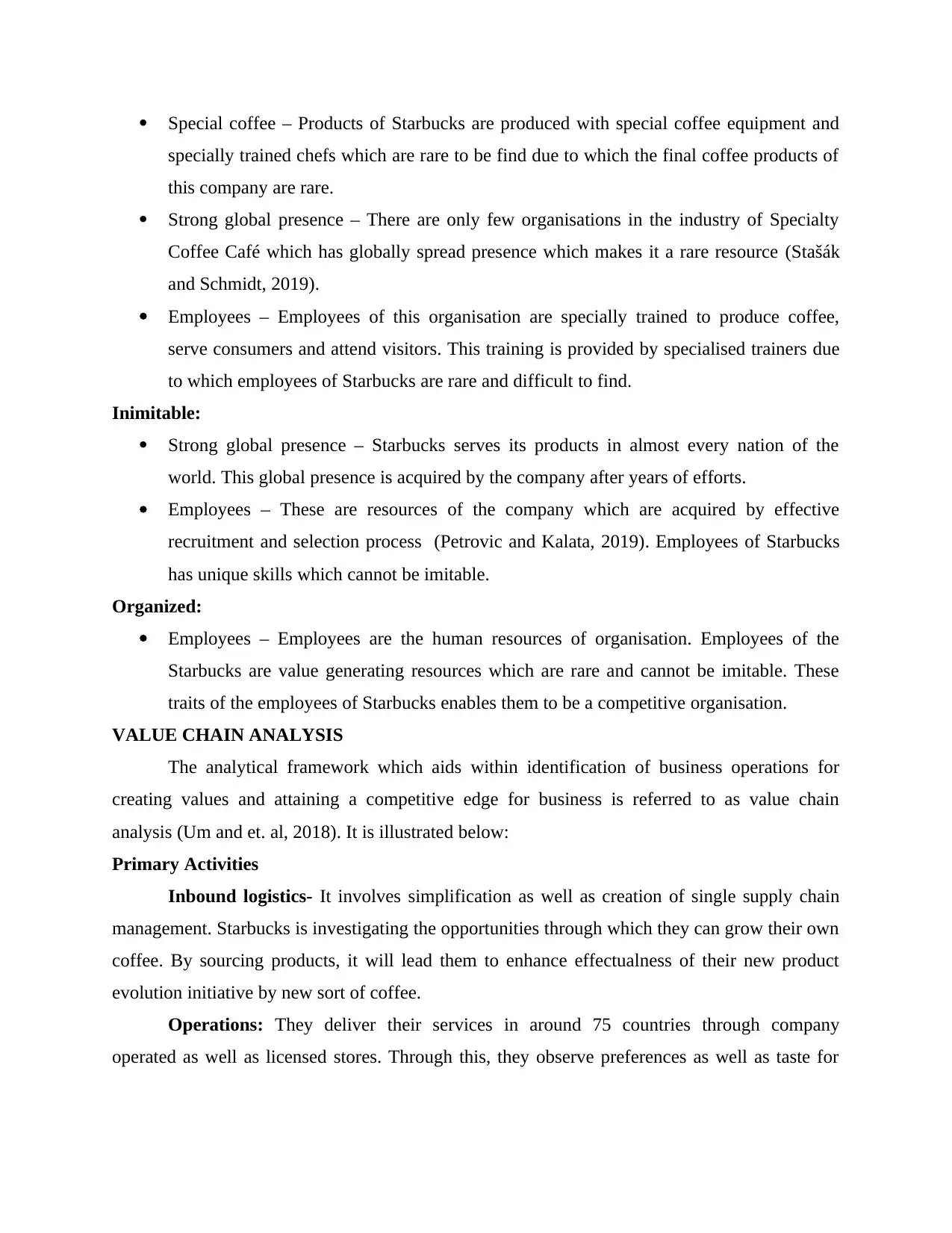
Special coffee – Products of Starbucks are produced with special coffee equipment and
specially trained chefs which are rare to be find due to which the final coffee products of
this company are rare.
Strong global presence – There are only few organisations in the industry of Specialty
Coffee Café which has globally spread presence which makes it a rare resource (Stašák
and Schmidt, 2019).
Employees – Employees of this organisation are specially trained to produce coffee,
serve consumers and attend visitors. This training is provided by specialised trainers due
to which employees of Starbucks are rare and difficult to find.
Inimitable:
Strong global presence – Starbucks serves its products in almost every nation of the
world. This global presence is acquired by the company after years of efforts.
Employees – These are resources of the company which are acquired by effective
recruitment and selection process (Petrovic and Kalata, 2019). Employees of Starbucks
has unique skills which cannot be imitable.
Organized:
Employees – Employees are the human resources of organisation. Employees of the
Starbucks are value generating resources which are rare and cannot be imitable. These
traits of the employees of Starbucks enables them to be a competitive organisation.
VALUE CHAIN ANALYSIS
The analytical framework which aids within identification of business operations for
creating values and attaining a competitive edge for business is referred to as value chain
analysis (Um and et. al, 2018). It is illustrated below:
Primary Activities
Inbound logistics- It involves simplification as well as creation of single supply chain
management. Starbucks is investigating the opportunities through which they can grow their own
coffee. By sourcing products, it will lead them to enhance effectualness of their new product
evolution initiative by new sort of coffee.
Operations: They deliver their services in around 75 countries through company
operated as well as licensed stores. Through this, they observe preferences as well as taste for
specially trained chefs which are rare to be find due to which the final coffee products of
this company are rare.
Strong global presence – There are only few organisations in the industry of Specialty
Coffee Café which has globally spread presence which makes it a rare resource (Stašák
and Schmidt, 2019).
Employees – Employees of this organisation are specially trained to produce coffee,
serve consumers and attend visitors. This training is provided by specialised trainers due
to which employees of Starbucks are rare and difficult to find.
Inimitable:
Strong global presence – Starbucks serves its products in almost every nation of the
world. This global presence is acquired by the company after years of efforts.
Employees – These are resources of the company which are acquired by effective
recruitment and selection process (Petrovic and Kalata, 2019). Employees of Starbucks
has unique skills which cannot be imitable.
Organized:
Employees – Employees are the human resources of organisation. Employees of the
Starbucks are value generating resources which are rare and cannot be imitable. These
traits of the employees of Starbucks enables them to be a competitive organisation.
VALUE CHAIN ANALYSIS
The analytical framework which aids within identification of business operations for
creating values and attaining a competitive edge for business is referred to as value chain
analysis (Um and et. al, 2018). It is illustrated below:
Primary Activities
Inbound logistics- It involves simplification as well as creation of single supply chain
management. Starbucks is investigating the opportunities through which they can grow their own
coffee. By sourcing products, it will lead them to enhance effectualness of their new product
evolution initiative by new sort of coffee.
Operations: They deliver their services in around 75 countries through company
operated as well as licensed stores. Through this, they observe preferences as well as taste for
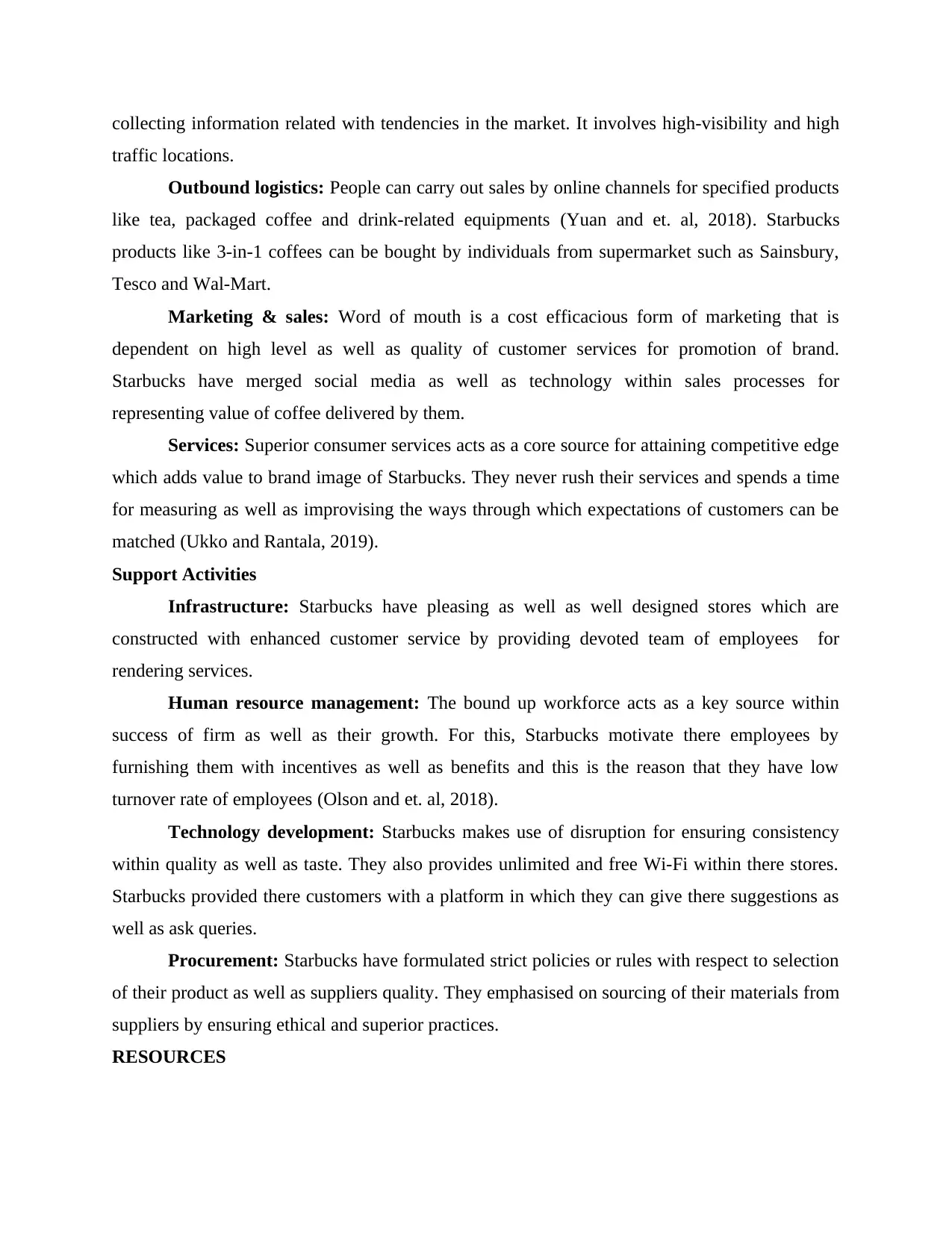
collecting information related with tendencies in the market. It involves high-visibility and high
traffic locations.
Outbound logistics: People can carry out sales by online channels for specified products
like tea, packaged coffee and drink-related equipments (Yuan and et. al, 2018). Starbucks
products like 3-in-1 coffees can be bought by individuals from supermarket such as Sainsbury,
Tesco and Wal-Mart.
Marketing & sales: Word of mouth is a cost efficacious form of marketing that is
dependent on high level as well as quality of customer services for promotion of brand.
Starbucks have merged social media as well as technology within sales processes for
representing value of coffee delivered by them.
Services: Superior consumer services acts as a core source for attaining competitive edge
which adds value to brand image of Starbucks. They never rush their services and spends a time
for measuring as well as improvising the ways through which expectations of customers can be
matched (Ukko and Rantala, 2019).
Support Activities
Infrastructure: Starbucks have pleasing as well as well designed stores which are
constructed with enhanced customer service by providing devoted team of employees for
rendering services.
Human resource management: The bound up workforce acts as a key source within
success of firm as well as their growth. For this, Starbucks motivate there employees by
furnishing them with incentives as well as benefits and this is the reason that they have low
turnover rate of employees (Olson and et. al, 2018).
Technology development: Starbucks makes use of disruption for ensuring consistency
within quality as well as taste. They also provides unlimited and free Wi-Fi within there stores.
Starbucks provided there customers with a platform in which they can give there suggestions as
well as ask queries.
Procurement: Starbucks have formulated strict policies or rules with respect to selection
of their product as well as suppliers quality. They emphasised on sourcing of their materials from
suppliers by ensuring ethical and superior practices.
RESOURCES
traffic locations.
Outbound logistics: People can carry out sales by online channels for specified products
like tea, packaged coffee and drink-related equipments (Yuan and et. al, 2018). Starbucks
products like 3-in-1 coffees can be bought by individuals from supermarket such as Sainsbury,
Tesco and Wal-Mart.
Marketing & sales: Word of mouth is a cost efficacious form of marketing that is
dependent on high level as well as quality of customer services for promotion of brand.
Starbucks have merged social media as well as technology within sales processes for
representing value of coffee delivered by them.
Services: Superior consumer services acts as a core source for attaining competitive edge
which adds value to brand image of Starbucks. They never rush their services and spends a time
for measuring as well as improvising the ways through which expectations of customers can be
matched (Ukko and Rantala, 2019).
Support Activities
Infrastructure: Starbucks have pleasing as well as well designed stores which are
constructed with enhanced customer service by providing devoted team of employees for
rendering services.
Human resource management: The bound up workforce acts as a key source within
success of firm as well as their growth. For this, Starbucks motivate there employees by
furnishing them with incentives as well as benefits and this is the reason that they have low
turnover rate of employees (Olson and et. al, 2018).
Technology development: Starbucks makes use of disruption for ensuring consistency
within quality as well as taste. They also provides unlimited and free Wi-Fi within there stores.
Starbucks provided there customers with a platform in which they can give there suggestions as
well as ask queries.
Procurement: Starbucks have formulated strict policies or rules with respect to selection
of their product as well as suppliers quality. They emphasised on sourcing of their materials from
suppliers by ensuring ethical and superior practices.
RESOURCES
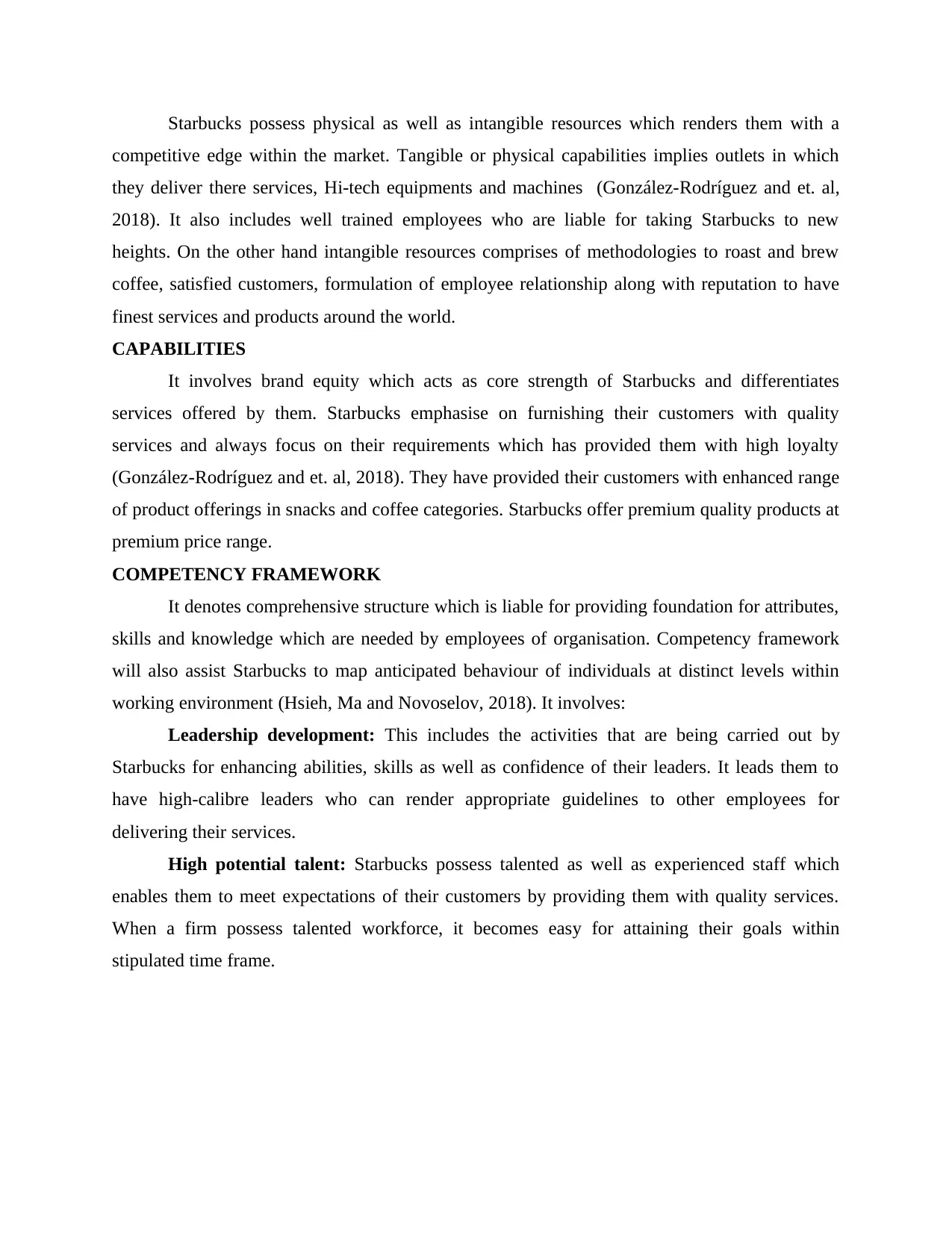
Starbucks possess physical as well as intangible resources which renders them with a
competitive edge within the market. Tangible or physical capabilities implies outlets in which
they deliver there services, Hi-tech equipments and machines (González-Rodríguez and et. al,
2018). It also includes well trained employees who are liable for taking Starbucks to new
heights. On the other hand intangible resources comprises of methodologies to roast and brew
coffee, satisfied customers, formulation of employee relationship along with reputation to have
finest services and products around the world.
CAPABILITIES
It involves brand equity which acts as core strength of Starbucks and differentiates
services offered by them. Starbucks emphasise on furnishing their customers with quality
services and always focus on their requirements which has provided them with high loyalty
(González-Rodríguez and et. al, 2018). They have provided their customers with enhanced range
of product offerings in snacks and coffee categories. Starbucks offer premium quality products at
premium price range.
COMPETENCY FRAMEWORK
It denotes comprehensive structure which is liable for providing foundation for attributes,
skills and knowledge which are needed by employees of organisation. Competency framework
will also assist Starbucks to map anticipated behaviour of individuals at distinct levels within
working environment (Hsieh, Ma and Novoselov, 2018). It involves:
Leadership development: This includes the activities that are being carried out by
Starbucks for enhancing abilities, skills as well as confidence of their leaders. It leads them to
have high-calibre leaders who can render appropriate guidelines to other employees for
delivering their services.
High potential talent: Starbucks possess talented as well as experienced staff which
enables them to meet expectations of their customers by providing them with quality services.
When a firm possess talented workforce, it becomes easy for attaining their goals within
stipulated time frame.
competitive edge within the market. Tangible or physical capabilities implies outlets in which
they deliver there services, Hi-tech equipments and machines (González-Rodríguez and et. al,
2018). It also includes well trained employees who are liable for taking Starbucks to new
heights. On the other hand intangible resources comprises of methodologies to roast and brew
coffee, satisfied customers, formulation of employee relationship along with reputation to have
finest services and products around the world.
CAPABILITIES
It involves brand equity which acts as core strength of Starbucks and differentiates
services offered by them. Starbucks emphasise on furnishing their customers with quality
services and always focus on their requirements which has provided them with high loyalty
(González-Rodríguez and et. al, 2018). They have provided their customers with enhanced range
of product offerings in snacks and coffee categories. Starbucks offer premium quality products at
premium price range.
COMPETENCY FRAMEWORK
It denotes comprehensive structure which is liable for providing foundation for attributes,
skills and knowledge which are needed by employees of organisation. Competency framework
will also assist Starbucks to map anticipated behaviour of individuals at distinct levels within
working environment (Hsieh, Ma and Novoselov, 2018). It involves:
Leadership development: This includes the activities that are being carried out by
Starbucks for enhancing abilities, skills as well as confidence of their leaders. It leads them to
have high-calibre leaders who can render appropriate guidelines to other employees for
delivering their services.
High potential talent: Starbucks possess talented as well as experienced staff which
enables them to meet expectations of their customers by providing them with quality services.
When a firm possess talented workforce, it becomes easy for attaining their goals within
stipulated time frame.
Secure Best Marks with AI Grader
Need help grading? Try our AI Grader for instant feedback on your assignments.

(Source: Competency Framework, 2019)
Recruitment and selection: As per the demand of particular role and responsibility, HR
of Starbucks carry out their process of recruitment as well as selection (Jermias, Gani and
Juliana, 2018). They screen their candidates through the usage of different online tools so that
they can acquire effective workforce.
Performance management: Starbucks set the benchmark for their employees with
respect to what they are expecting from them. This enables employees to acknowledge what
company needs and how they work for attaining them (Oldman and Tomkins, 2018).
Succession planning: It is important to identify the gap which exist in between teams as
well as individuals so that strategies can be formulated to overcome those. For this modules can
be created for rendering enhanced development as well as training resources.
Rewards and recognition: For motivating employees, they are provided with distinct
rewards as well as recognition which boost up their morale to work in enhanced manner while
delivering their services (Lu and et. al, 2018). This leads to creation of affirmative working
environment within Starbucks.
Illustration 1: Competency Framework
Recruitment and selection: As per the demand of particular role and responsibility, HR
of Starbucks carry out their process of recruitment as well as selection (Jermias, Gani and
Juliana, 2018). They screen their candidates through the usage of different online tools so that
they can acquire effective workforce.
Performance management: Starbucks set the benchmark for their employees with
respect to what they are expecting from them. This enables employees to acknowledge what
company needs and how they work for attaining them (Oldman and Tomkins, 2018).
Succession planning: It is important to identify the gap which exist in between teams as
well as individuals so that strategies can be formulated to overcome those. For this modules can
be created for rendering enhanced development as well as training resources.
Rewards and recognition: For motivating employees, they are provided with distinct
rewards as well as recognition which boost up their morale to work in enhanced manner while
delivering their services (Lu and et. al, 2018). This leads to creation of affirmative working
environment within Starbucks.
Illustration 1: Competency Framework
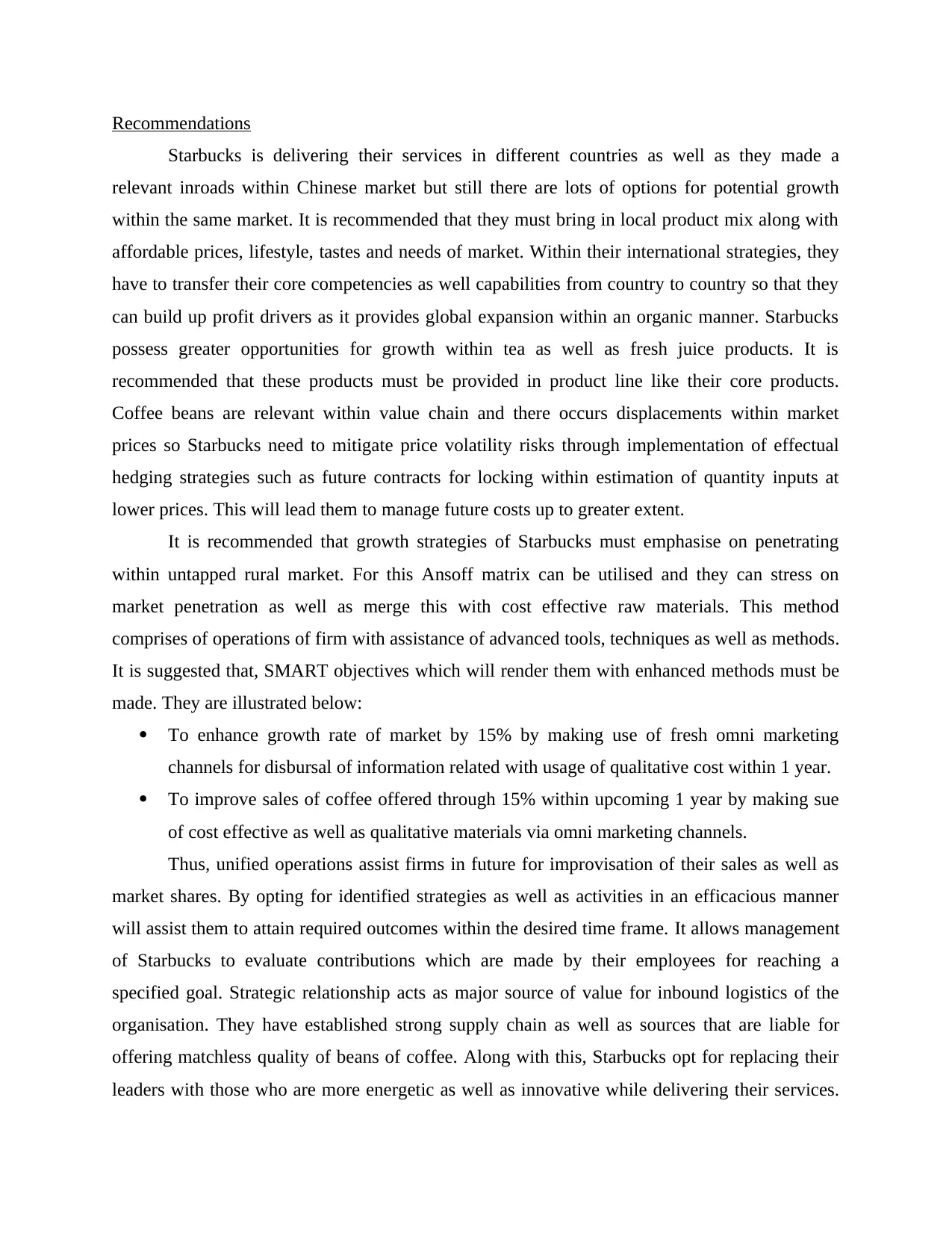
Recommendations
Starbucks is delivering their services in different countries as well as they made a
relevant inroads within Chinese market but still there are lots of options for potential growth
within the same market. It is recommended that they must bring in local product mix along with
affordable prices, lifestyle, tastes and needs of market. Within their international strategies, they
have to transfer their core competencies as well capabilities from country to country so that they
can build up profit drivers as it provides global expansion within an organic manner. Starbucks
possess greater opportunities for growth within tea as well as fresh juice products. It is
recommended that these products must be provided in product line like their core products.
Coffee beans are relevant within value chain and there occurs displacements within market
prices so Starbucks need to mitigate price volatility risks through implementation of effectual
hedging strategies such as future contracts for locking within estimation of quantity inputs at
lower prices. This will lead them to manage future costs up to greater extent.
It is recommended that growth strategies of Starbucks must emphasise on penetrating
within untapped rural market. For this Ansoff matrix can be utilised and they can stress on
market penetration as well as merge this with cost effective raw materials. This method
comprises of operations of firm with assistance of advanced tools, techniques as well as methods.
It is suggested that, SMART objectives which will render them with enhanced methods must be
made. They are illustrated below:
To enhance growth rate of market by 15% by making use of fresh omni marketing
channels for disbursal of information related with usage of qualitative cost within 1 year.
To improve sales of coffee offered through 15% within upcoming 1 year by making sue
of cost effective as well as qualitative materials via omni marketing channels.
Thus, unified operations assist firms in future for improvisation of their sales as well as
market shares. By opting for identified strategies as well as activities in an efficacious manner
will assist them to attain required outcomes within the desired time frame. It allows management
of Starbucks to evaluate contributions which are made by their employees for reaching a
specified goal. Strategic relationship acts as major source of value for inbound logistics of the
organisation. They have established strong supply chain as well as sources that are liable for
offering matchless quality of beans of coffee. Along with this, Starbucks opt for replacing their
leaders with those who are more energetic as well as innovative while delivering their services.
Starbucks is delivering their services in different countries as well as they made a
relevant inroads within Chinese market but still there are lots of options for potential growth
within the same market. It is recommended that they must bring in local product mix along with
affordable prices, lifestyle, tastes and needs of market. Within their international strategies, they
have to transfer their core competencies as well capabilities from country to country so that they
can build up profit drivers as it provides global expansion within an organic manner. Starbucks
possess greater opportunities for growth within tea as well as fresh juice products. It is
recommended that these products must be provided in product line like their core products.
Coffee beans are relevant within value chain and there occurs displacements within market
prices so Starbucks need to mitigate price volatility risks through implementation of effectual
hedging strategies such as future contracts for locking within estimation of quantity inputs at
lower prices. This will lead them to manage future costs up to greater extent.
It is recommended that growth strategies of Starbucks must emphasise on penetrating
within untapped rural market. For this Ansoff matrix can be utilised and they can stress on
market penetration as well as merge this with cost effective raw materials. This method
comprises of operations of firm with assistance of advanced tools, techniques as well as methods.
It is suggested that, SMART objectives which will render them with enhanced methods must be
made. They are illustrated below:
To enhance growth rate of market by 15% by making use of fresh omni marketing
channels for disbursal of information related with usage of qualitative cost within 1 year.
To improve sales of coffee offered through 15% within upcoming 1 year by making sue
of cost effective as well as qualitative materials via omni marketing channels.
Thus, unified operations assist firms in future for improvisation of their sales as well as
market shares. By opting for identified strategies as well as activities in an efficacious manner
will assist them to attain required outcomes within the desired time frame. It allows management
of Starbucks to evaluate contributions which are made by their employees for reaching a
specified goal. Strategic relationship acts as major source of value for inbound logistics of the
organisation. They have established strong supply chain as well as sources that are liable for
offering matchless quality of beans of coffee. Along with this, Starbucks opt for replacing their
leaders with those who are more energetic as well as innovative while delivering their services.
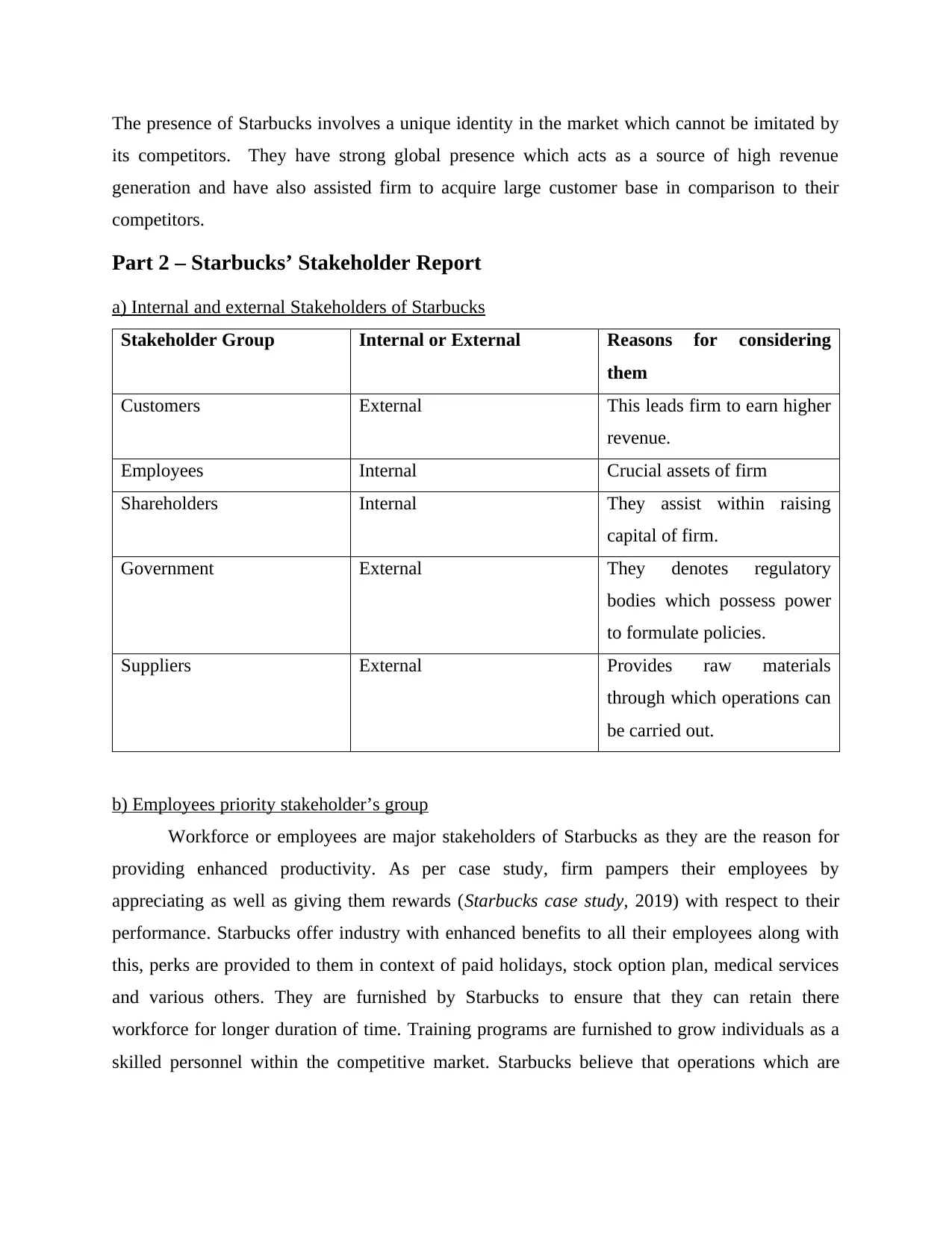
The presence of Starbucks involves a unique identity in the market which cannot be imitated by
its competitors. They have strong global presence which acts as a source of high revenue
generation and have also assisted firm to acquire large customer base in comparison to their
competitors.
Part 2 – Starbucks’ Stakeholder Report
a) Internal and external Stakeholders of Starbucks
Stakeholder Group Internal or External Reasons for considering
them
Customers External This leads firm to earn higher
revenue.
Employees Internal Crucial assets of firm
Shareholders Internal They assist within raising
capital of firm.
Government External They denotes regulatory
bodies which possess power
to formulate policies.
Suppliers External Provides raw materials
through which operations can
be carried out.
b) Employees priority stakeholder’s group
Workforce or employees are major stakeholders of Starbucks as they are the reason for
providing enhanced productivity. As per case study, firm pampers their employees by
appreciating as well as giving them rewards (Starbucks case study, 2019) with respect to their
performance. Starbucks offer industry with enhanced benefits to all their employees along with
this, perks are provided to them in context of paid holidays, stock option plan, medical services
and various others. They are furnished by Starbucks to ensure that they can retain there
workforce for longer duration of time. Training programs are furnished to grow individuals as a
skilled personnel within the competitive market. Starbucks believe that operations which are
its competitors. They have strong global presence which acts as a source of high revenue
generation and have also assisted firm to acquire large customer base in comparison to their
competitors.
Part 2 – Starbucks’ Stakeholder Report
a) Internal and external Stakeholders of Starbucks
Stakeholder Group Internal or External Reasons for considering
them
Customers External This leads firm to earn higher
revenue.
Employees Internal Crucial assets of firm
Shareholders Internal They assist within raising
capital of firm.
Government External They denotes regulatory
bodies which possess power
to formulate policies.
Suppliers External Provides raw materials
through which operations can
be carried out.
b) Employees priority stakeholder’s group
Workforce or employees are major stakeholders of Starbucks as they are the reason for
providing enhanced productivity. As per case study, firm pampers their employees by
appreciating as well as giving them rewards (Starbucks case study, 2019) with respect to their
performance. Starbucks offer industry with enhanced benefits to all their employees along with
this, perks are provided to them in context of paid holidays, stock option plan, medical services
and various others. They are furnished by Starbucks to ensure that they can retain there
workforce for longer duration of time. Training programs are furnished to grow individuals as a
skilled personnel within the competitive market. Starbucks believe that operations which are
Paraphrase This Document
Need a fresh take? Get an instant paraphrase of this document with our AI Paraphraser
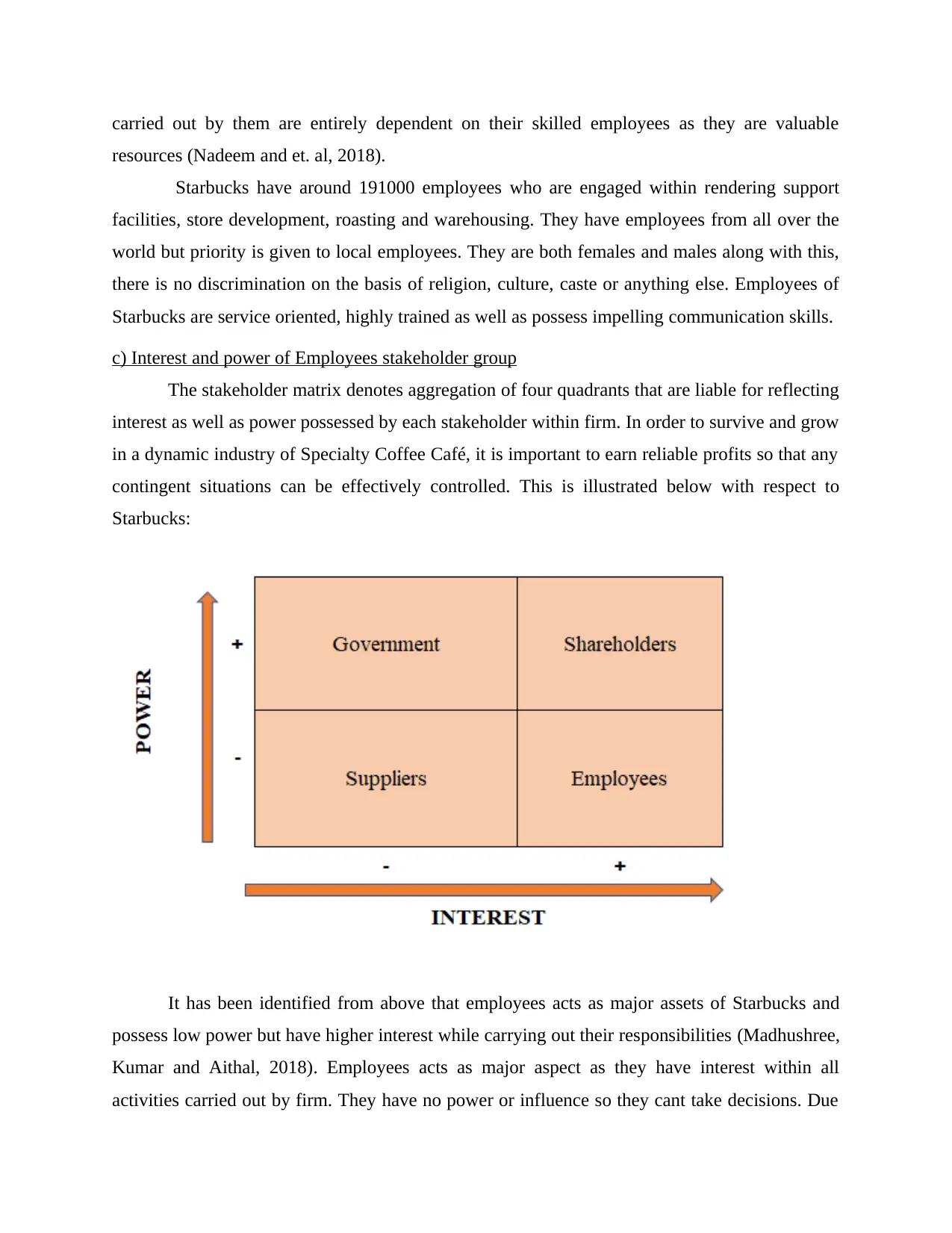
carried out by them are entirely dependent on their skilled employees as they are valuable
resources (Nadeem and et. al, 2018).
Starbucks have around 191000 employees who are engaged within rendering support
facilities, store development, roasting and warehousing. They have employees from all over the
world but priority is given to local employees. They are both females and males along with this,
there is no discrimination on the basis of religion, culture, caste or anything else. Employees of
Starbucks are service oriented, highly trained as well as possess impelling communication skills.
c) Interest and power of Employees stakeholder group
The stakeholder matrix denotes aggregation of four quadrants that are liable for reflecting
interest as well as power possessed by each stakeholder within firm. In order to survive and grow
in a dynamic industry of Specialty Coffee Café, it is important to earn reliable profits so that any
contingent situations can be effectively controlled. This is illustrated below with respect to
Starbucks:
It has been identified from above that employees acts as major assets of Starbucks and
possess low power but have higher interest while carrying out their responsibilities (Madhushree,
Kumar and Aithal, 2018). Employees acts as major aspect as they have interest within all
activities carried out by firm. They have no power or influence so they cant take decisions. Due
resources (Nadeem and et. al, 2018).
Starbucks have around 191000 employees who are engaged within rendering support
facilities, store development, roasting and warehousing. They have employees from all over the
world but priority is given to local employees. They are both females and males along with this,
there is no discrimination on the basis of religion, culture, caste or anything else. Employees of
Starbucks are service oriented, highly trained as well as possess impelling communication skills.
c) Interest and power of Employees stakeholder group
The stakeholder matrix denotes aggregation of four quadrants that are liable for reflecting
interest as well as power possessed by each stakeholder within firm. In order to survive and grow
in a dynamic industry of Specialty Coffee Café, it is important to earn reliable profits so that any
contingent situations can be effectively controlled. This is illustrated below with respect to
Starbucks:
It has been identified from above that employees acts as major assets of Starbucks and
possess low power but have higher interest while carrying out their responsibilities (Madhushree,
Kumar and Aithal, 2018). Employees acts as major aspect as they have interest within all
activities carried out by firm. They have no power or influence so they cant take decisions. Due
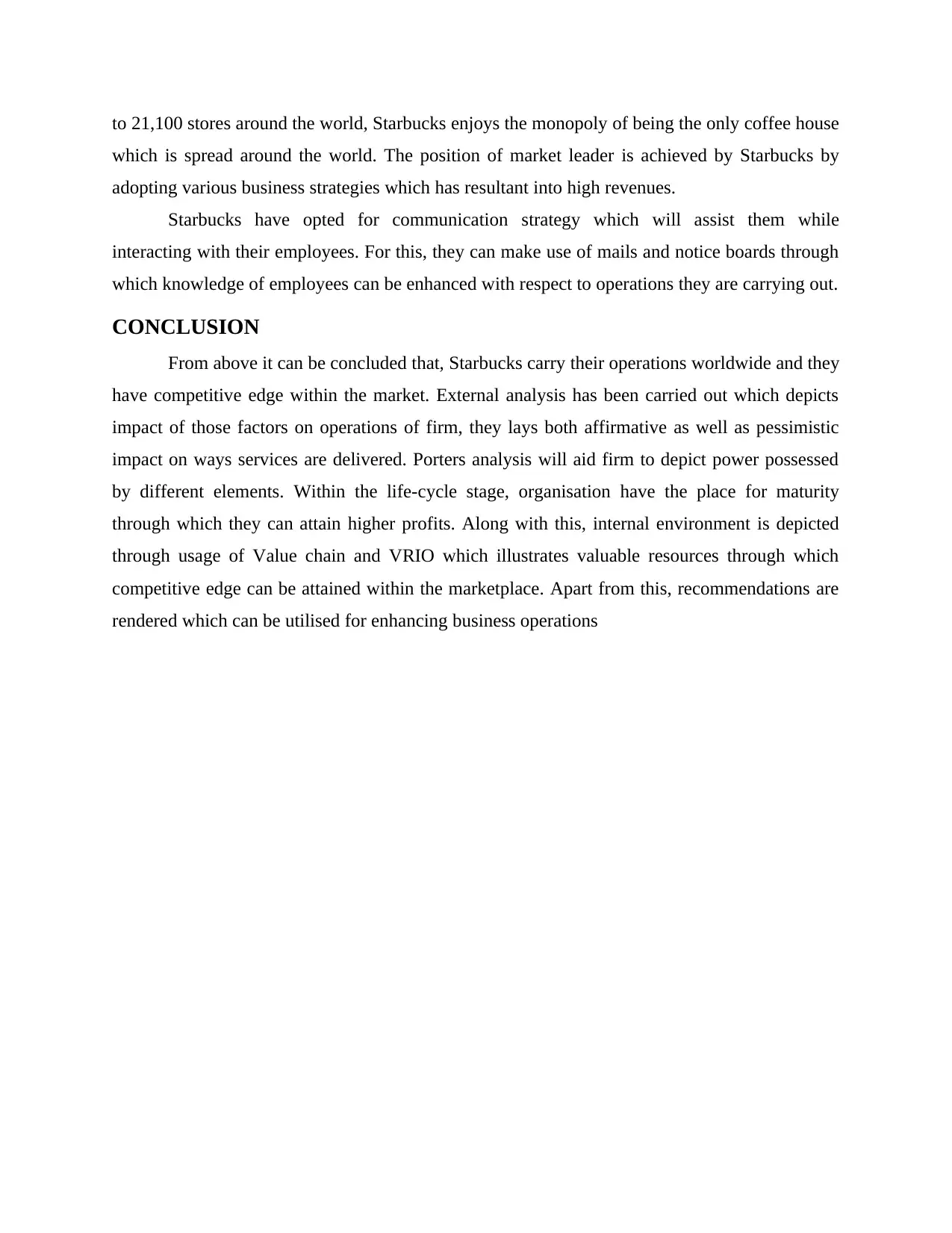
to 21,100 stores around the world, Starbucks enjoys the monopoly of being the only coffee house
which is spread around the world. The position of market leader is achieved by Starbucks by
adopting various business strategies which has resultant into high revenues.
Starbucks have opted for communication strategy which will assist them while
interacting with their employees. For this, they can make use of mails and notice boards through
which knowledge of employees can be enhanced with respect to operations they are carrying out.
CONCLUSION
From above it can be concluded that, Starbucks carry their operations worldwide and they
have competitive edge within the market. External analysis has been carried out which depicts
impact of those factors on operations of firm, they lays both affirmative as well as pessimistic
impact on ways services are delivered. Porters analysis will aid firm to depict power possessed
by different elements. Within the life-cycle stage, organisation have the place for maturity
through which they can attain higher profits. Along with this, internal environment is depicted
through usage of Value chain and VRIO which illustrates valuable resources through which
competitive edge can be attained within the marketplace. Apart from this, recommendations are
rendered which can be utilised for enhancing business operations
which is spread around the world. The position of market leader is achieved by Starbucks by
adopting various business strategies which has resultant into high revenues.
Starbucks have opted for communication strategy which will assist them while
interacting with their employees. For this, they can make use of mails and notice boards through
which knowledge of employees can be enhanced with respect to operations they are carrying out.
CONCLUSION
From above it can be concluded that, Starbucks carry their operations worldwide and they
have competitive edge within the market. External analysis has been carried out which depicts
impact of those factors on operations of firm, they lays both affirmative as well as pessimistic
impact on ways services are delivered. Porters analysis will aid firm to depict power possessed
by different elements. Within the life-cycle stage, organisation have the place for maturity
through which they can attain higher profits. Along with this, internal environment is depicted
through usage of Value chain and VRIO which illustrates valuable resources through which
competitive edge can be attained within the marketplace. Apart from this, recommendations are
rendered which can be utilised for enhancing business operations
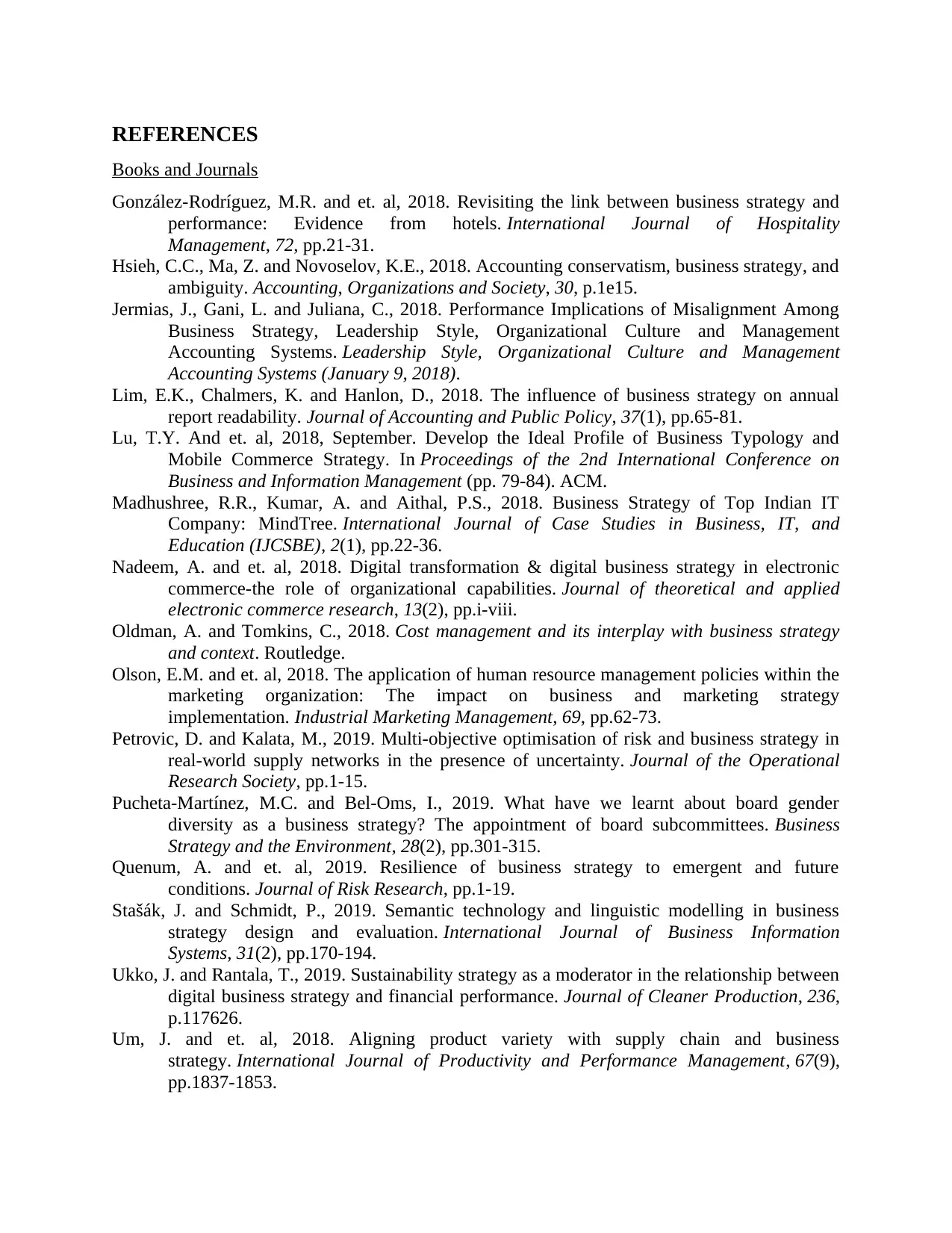
REFERENCES
Books and Journals
González-Rodríguez, M.R. and et. al, 2018. Revisiting the link between business strategy and
performance: Evidence from hotels. International Journal of Hospitality
Management, 72, pp.21-31.
Hsieh, C.C., Ma, Z. and Novoselov, K.E., 2018. Accounting conservatism, business strategy, and
ambiguity. Accounting, Organizations and Society, 30, p.1e15.
Jermias, J., Gani, L. and Juliana, C., 2018. Performance Implications of Misalignment Among
Business Strategy, Leadership Style, Organizational Culture and Management
Accounting Systems. Leadership Style, Organizational Culture and Management
Accounting Systems (January 9, 2018).
Lim, E.K., Chalmers, K. and Hanlon, D., 2018. The influence of business strategy on annual
report readability. Journal of Accounting and Public Policy, 37(1), pp.65-81.
Lu, T.Y. And et. al, 2018, September. Develop the Ideal Profile of Business Typology and
Mobile Commerce Strategy. In Proceedings of the 2nd International Conference on
Business and Information Management (pp. 79-84). ACM.
Madhushree, R.R., Kumar, A. and Aithal, P.S., 2018. Business Strategy of Top Indian IT
Company: MindTree. International Journal of Case Studies in Business, IT, and
Education (IJCSBE), 2(1), pp.22-36.
Nadeem, A. and et. al, 2018. Digital transformation & digital business strategy in electronic
commerce-the role of organizational capabilities. Journal of theoretical and applied
electronic commerce research, 13(2), pp.i-viii.
Oldman, A. and Tomkins, C., 2018. Cost management and its interplay with business strategy
and context. Routledge.
Olson, E.M. and et. al, 2018. The application of human resource management policies within the
marketing organization: The impact on business and marketing strategy
implementation. Industrial Marketing Management, 69, pp.62-73.
Petrovic, D. and Kalata, M., 2019. Multi-objective optimisation of risk and business strategy in
real-world supply networks in the presence of uncertainty. Journal of the Operational
Research Society, pp.1-15.
Pucheta‐Martínez, M.C. and Bel‐Oms, I., 2019. What have we learnt about board gender
diversity as a business strategy? The appointment of board subcommittees. Business
Strategy and the Environment, 28(2), pp.301-315.
Quenum, A. and et. al, 2019. Resilience of business strategy to emergent and future
conditions. Journal of Risk Research, pp.1-19.
Stašák, J. and Schmidt, P., 2019. Semantic technology and linguistic modelling in business
strategy design and evaluation. International Journal of Business Information
Systems, 31(2), pp.170-194.
Ukko, J. and Rantala, T., 2019. Sustainability strategy as a moderator in the relationship between
digital business strategy and financial performance. Journal of Cleaner Production, 236,
p.117626.
Um, J. and et. al, 2018. Aligning product variety with supply chain and business
strategy. International Journal of Productivity and Performance Management, 67(9),
pp.1837-1853.
Books and Journals
González-Rodríguez, M.R. and et. al, 2018. Revisiting the link between business strategy and
performance: Evidence from hotels. International Journal of Hospitality
Management, 72, pp.21-31.
Hsieh, C.C., Ma, Z. and Novoselov, K.E., 2018. Accounting conservatism, business strategy, and
ambiguity. Accounting, Organizations and Society, 30, p.1e15.
Jermias, J., Gani, L. and Juliana, C., 2018. Performance Implications of Misalignment Among
Business Strategy, Leadership Style, Organizational Culture and Management
Accounting Systems. Leadership Style, Organizational Culture and Management
Accounting Systems (January 9, 2018).
Lim, E.K., Chalmers, K. and Hanlon, D., 2018. The influence of business strategy on annual
report readability. Journal of Accounting and Public Policy, 37(1), pp.65-81.
Lu, T.Y. And et. al, 2018, September. Develop the Ideal Profile of Business Typology and
Mobile Commerce Strategy. In Proceedings of the 2nd International Conference on
Business and Information Management (pp. 79-84). ACM.
Madhushree, R.R., Kumar, A. and Aithal, P.S., 2018. Business Strategy of Top Indian IT
Company: MindTree. International Journal of Case Studies in Business, IT, and
Education (IJCSBE), 2(1), pp.22-36.
Nadeem, A. and et. al, 2018. Digital transformation & digital business strategy in electronic
commerce-the role of organizational capabilities. Journal of theoretical and applied
electronic commerce research, 13(2), pp.i-viii.
Oldman, A. and Tomkins, C., 2018. Cost management and its interplay with business strategy
and context. Routledge.
Olson, E.M. and et. al, 2018. The application of human resource management policies within the
marketing organization: The impact on business and marketing strategy
implementation. Industrial Marketing Management, 69, pp.62-73.
Petrovic, D. and Kalata, M., 2019. Multi-objective optimisation of risk and business strategy in
real-world supply networks in the presence of uncertainty. Journal of the Operational
Research Society, pp.1-15.
Pucheta‐Martínez, M.C. and Bel‐Oms, I., 2019. What have we learnt about board gender
diversity as a business strategy? The appointment of board subcommittees. Business
Strategy and the Environment, 28(2), pp.301-315.
Quenum, A. and et. al, 2019. Resilience of business strategy to emergent and future
conditions. Journal of Risk Research, pp.1-19.
Stašák, J. and Schmidt, P., 2019. Semantic technology and linguistic modelling in business
strategy design and evaluation. International Journal of Business Information
Systems, 31(2), pp.170-194.
Ukko, J. and Rantala, T., 2019. Sustainability strategy as a moderator in the relationship between
digital business strategy and financial performance. Journal of Cleaner Production, 236,
p.117626.
Um, J. and et. al, 2018. Aligning product variety with supply chain and business
strategy. International Journal of Productivity and Performance Management, 67(9),
pp.1837-1853.
Secure Best Marks with AI Grader
Need help grading? Try our AI Grader for instant feedback on your assignments.
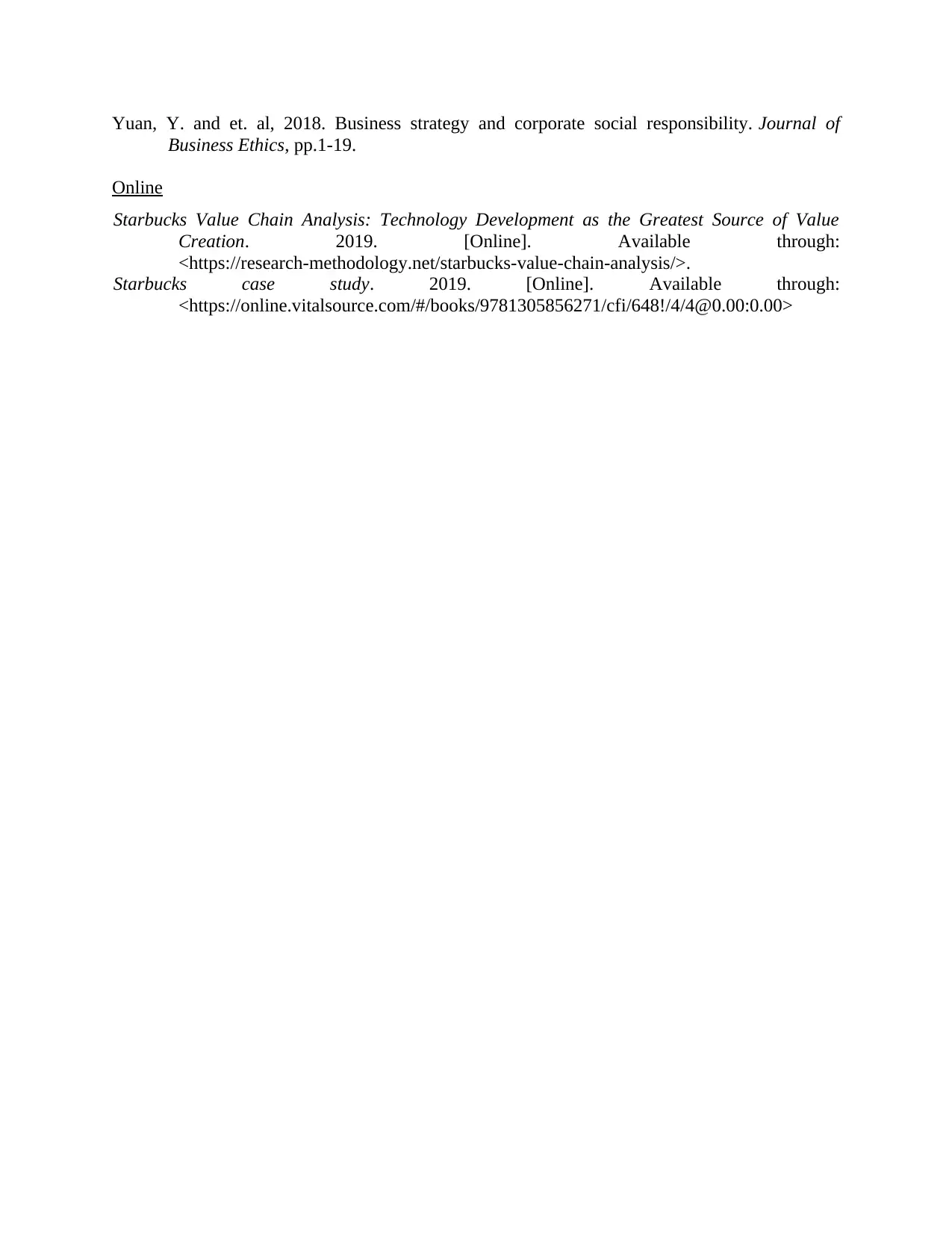
Yuan, Y. and et. al, 2018. Business strategy and corporate social responsibility. Journal of
Business Ethics, pp.1-19.
Online
Starbucks Value Chain Analysis: Technology Development as the Greatest Source of Value
Creation. 2019. [Online]. Available through:
<https://research-methodology.net/starbucks-value-chain-analysis/>.
Starbucks case study. 2019. [Online]. Available through:
<https://online.vitalsource.com/#/books/9781305856271/cfi/648!/4/4@0.00:0.00>
Business Ethics, pp.1-19.
Online
Starbucks Value Chain Analysis: Technology Development as the Greatest Source of Value
Creation. 2019. [Online]. Available through:
<https://research-methodology.net/starbucks-value-chain-analysis/>.
Starbucks case study. 2019. [Online]. Available through:
<https://online.vitalsource.com/#/books/9781305856271/cfi/648!/4/4@0.00:0.00>
1 out of 17
Related Documents
Your All-in-One AI-Powered Toolkit for Academic Success.
+13062052269
info@desklib.com
Available 24*7 on WhatsApp / Email
![[object Object]](/_next/static/media/star-bottom.7253800d.svg)
Unlock your academic potential
© 2024 | Zucol Services PVT LTD | All rights reserved.





